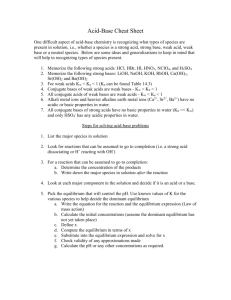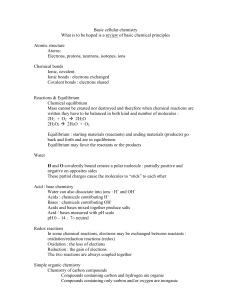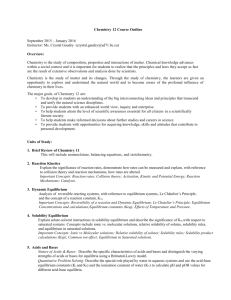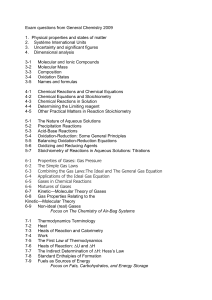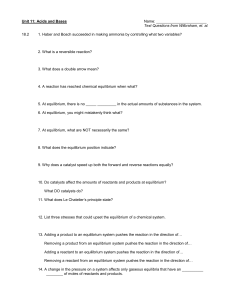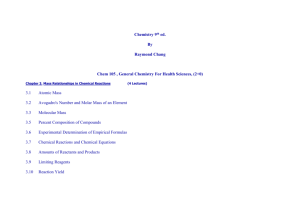Acid-Base Buffer Equilibrium
advertisement
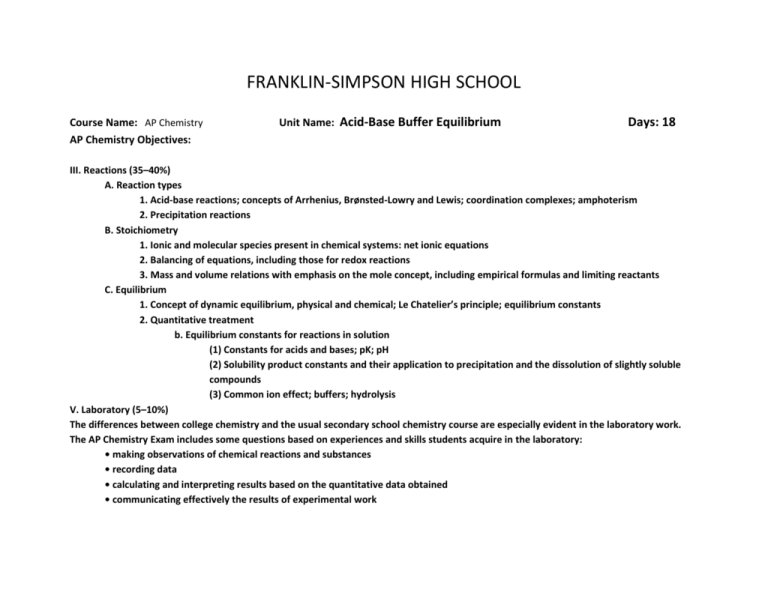
FRANKLIN-SIMPSON HIGH SCHOOL Course Name: AP Chemistry AP Chemistry Objectives: Unit Name: Acid-Base Buffer Equilibrium Days: 18 III. Reactions (35–40%) A. Reaction types 1. Acid-base reactions; concepts of Arrhenius, Brønsted-Lowry and Lewis; coordination complexes; amphoterism 2. Precipitation reactions B. Stoichiometry 1. Ionic and molecular species present in chemical systems: net ionic equations 2. Balancing of equations, including those for redox reactions 3. Mass and volume relations with emphasis on the mole concept, including empirical formulas and limiting reactants C. Equilibrium 1. Concept of dynamic equilibrium, physical and chemical; Le Chatelier’s principle; equilibrium constants 2. Quantitative treatment b. Equilibrium constants for reactions in solution (1) Constants for acids and bases; pK; pH (2) Solubility product constants and their application to precipitation and the dissolution of slightly soluble compounds (3) Common ion effect; buffers; hydrolysis V. Laboratory (5–10%) The differences between college chemistry and the usual secondary school chemistry course are especially evident in the laboratory work. The AP Chemistry Exam includes some questions based on experiences and skills students acquire in the laboratory: • making observations of chemical reactions and substances • recording data • calculating and interpreting results based on the quantitative data obtained • communicating effectively the results of experimental work Purpose of the Unit: Students have just completed the general solubility equilibrium unit and were familiarized with the dissociation constant K, Ksp, Keq, Kc, Kp, etc. In this unit we will expand students understanding of equilibrium to include acids, bases, and buffers. Students will discern the differences between strong and weak acids and bases and the implications each type of system has on the state of equilibrium. Students will also examine three different definitions scientists use to define acids and bases and weigh the pros and cons of each definition. In addition to computing calculations associated with titrations, students will also examine various buffer systems, applications of those systems, and learn how to make effective buffers. Prerequisites: Students will need an understanding of: *LeChatlier’s principle * Solubility rules * General Solubility Daily Lesson Guide Day 1-3 Lesson Content and Objectives Equilibrium: AcidBase Theory & pH III.A.1, 2 Focus Questions * How are acids and bases defined and what are the implications of each definition? Critical Thinking (High Yield / Literacy /LTF/etc.) * Summarizing and note taking * I Do – We Do – You Do * Analysis/ Application * Learning with others Engagement * ACT bell ringer * Take notes on modeled notes * Solve problems within notes solo and in small groups (formative) Assessment and/or Accommodations * Evaluate student sample problems for understanding 4-6 Equilibrium: Weak Acid-Base pH Calculations III.C.1 III.C.2.b.1, 2, 3 * How is pH calculated for strong and weak acids and bases? * How are pH calculations related to other equilibrium calculations? * Summarizing and note taking * I Do – We Do – You Do * Analysis/ Application * Learning with others * ACT bell ringer * Take notes on modeled notes * Solve problems within notes solo and in small groups (formative) * Evaluate student sample problems for understanding 7-8 Equilibrium: Buffers Made Easy III.A.1 III.B.1, 2, 3 III.C.1 III.C.2.b.1, 2, 3 * What are buffer systems? * What are real-life applications of buffer systems? * How can I construct and effective buffer? * Summarizing and note taking * I Do – We Do – You Do * Analysis/ Application * Learning with others * ACT bell ringer * Take notes on modeled notes * Solve problems within notes solo and in small groups (formative) * Evaluate student sample problems for understanding 9-11 AP Acid-Base and Buffer FRQs and MC questions III.A.1, 2 III.B.1, 2, 3 III.C.1 III.C.2.b.1, 2, 3 * How will I be tested over acid-base equilibrium and buffers on the AP Chemistry Exam? * How does everything I just learned fit together with what I already know? * Learning with others * Choice * Clickers * ACT bell ringer * Work independently, then in small groups, then as whole class to solve and grade FRQ’s with AP rubrics * Use clickers and Turning Point to answers MC Questions from retired AP exams (summative) * Evaluate student responses and provide immediate feedback on FRQ’s and MC’s with rubrics and keys 1214 1516 1718 Laboratory: AP required lab 6 and 7: Standardization of NaOH and Acid-Base Titration III.A.1, 2 III.B.1, 2, 3 III.C.1 III.C.2.b.1, 2, 3 V. Laboratory: AP required lab 11 and 19: Determination of Appropriate Indicators & Buffers III.A.1, 2 III.B.1, 2, 3 III.C.1 III.C.2.b.1, 2, 3 V. Unit Exam III.A.1, 2 III.B.1, 2, 3 III.C.1 III.C.2.b.1, 2, 3 V. * How can I experimentally determine: standard concentration of a titrant, equivalent mass of an unknown acid, and the Ka of an unknown weak acid? * Learning with Others * Generating and testing Hypotheses * Authenticity * Novelty and Variety * Analysis/ Applications/ Synthesis * How do I select the appropriate indicator for acid-base titration? * Does the strength of the acid and base affect the choice of indicator? * Learning with Others * Generating and testing Hypotheses * Authenticity * Novelty and Variety * Analysis/ Applications/ Synthesis * Can I use my knowledge to take an AP-like exam covering acids, bases, and buffers? * Evaluation * Analysis * Application * Synthesis * Authenticity * ACT bell ringer * Work in small lab groups to solve a lab problem * Use data collected to calculate concentration of NaOH and an unknown acid (summative) * ACT bell ringer * Work in small lab groups to solve a lab problem * Use data collected to determine the best indicator for a titration and buffer (summative) * Evaluate lab reports * Students can check themselves by verifying their results among other lab groups * ACT bell ringer * Solve retired AP Chemistry MC and FR Questions * Graded by AP standards and rubrics (summative) * Evaluate exam * Evaluate lab reports * Students can check themselves by verifying their results among other lab groups
